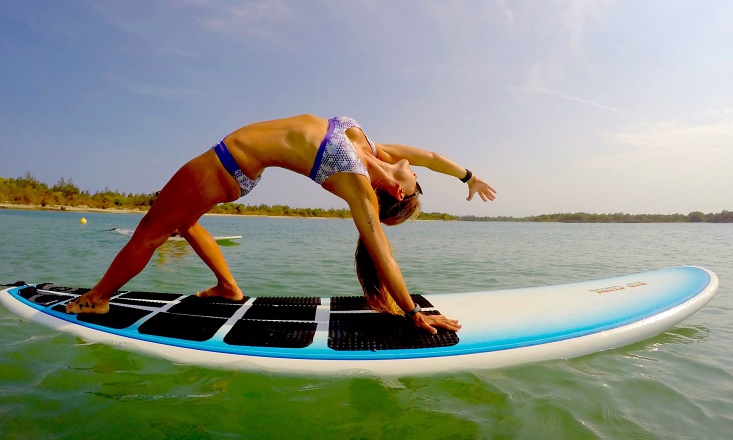SUP Yoga is making waves in the yoga world – but are you still hesitant to test the water? Sure you’ve heard all the fitness and meditation benefits of a class on the beautiful blue ocean…but isn’t it too challenging?
"Is it even a real yoga class? What about alignment onboard a floating yoga mat?" Get ready to grab yourself a board as we throw these three common myths about the practice out to sea!
Myth 1: Yoga on the sea is more challenging than yoga on land.
Most SUP yoga classes consist of poses accessible to all levels. In fact, many people comment after a SUP yoga class “that wasn't as hard as I thought!"
This is because most poses in a SUP Yoga class are either sitting, on the knees or reclined on the back. These are stable poses on the SUP board and as such, don't need much balancing.
That’s not to say that SUP Yoga doesn't have something for those who like a challenge. Standing poses, arm balances and inversions become more demanding as they require core strength, balance and concentration, so the board is a great place to increase your skills in these areas. However, in beginner classes, these poses will only be a small part of the practice, so there is no reason to fear giving it a try.
Myth 2: SUP Yoga isn't real yoga, it's a novelty.
There is certainly an aspect of fun to practicing yoga on a board floating in the ocean, but SUP yoga still delves us into the deeper aspects of yogic philosophy and brings us closer to the experience of chitta vritti nirodhah – cessation of the fluctuations of the mind.
The sea is a powerful, mystical place to practice yoga. The SUP Yogi draws on Indriya – the senses – to become completely mindful in the present moment. In the ocean, there is so much to focus the wandering mind; the sound of the water lapping under the board, the sight of soaring sea birds, the smell of the sea salt, the feeling of the breeze on the skin.
This allows you to become totally captivated by the surroundings, accessing a deep state of meditation and relaxation.
Science shows the human body to be made up of up to 75% water. We are water. We came from water, growing and developing in the womb. The ocean recaptures this essential human experience of floating and being supported.
Mantras specific to the ocean are chanted to further connect the SUP Yogi to their true nature, the present moment, and to the greater universe around us.
SUP yoga practitioners are encouraged to practice Ahimsa or non-violence, the first of five yamas or moral guidelines in Patanjali’s eight-limbed yogic path. Ahimsa encourages kindness toward the self and all beings. SUP yoga teachers are ambassadors of the oceanic environment, practicing non-violence to all living creatures and passing this message on to those who practice SUP yoga.
A greater appreciation and gratitude for our mother earth and the ocean is a natural consequence of connecting deeply to the environment around you on the board.
Myth 3: Alignment will be jeopardised on a SUP board.
Creative use of the SUP board as a prop during SUP Yoga practice is one of the ways we maintain correct posture and alignment in a class. The SUP boards used to practice SUP yoga are generally big, wide and have a lot of buoyancy. They are remarkably stable which means positioning and holding of yoga postures is not compromised.
Standing poses can be done on the SUP board by moving diagonally on the board to cover more board surface area and to promote increased balance so the pose can be held for a specific length of time.
SUP Yoga encourages an even greater awareness of the qualities of the yogic breath; dirgha (long) and sukshma (subtle). SUP Yogis rely on this connection to the breath to keep poses steady on the board, encouraging balance, self-focus and concentration. This also brings us into a greater state of meditative stillness and connection.
For seekers on the yogic path, taking your class to the water combines all the benefits of a traditional class with the magical experience of connecting and being supported by the beautiful big blue ocean surrounding us.
Grab a board and join the many SUP Yogis finding that peace really is floating out to sea.
Image credit: Chantal Crinquand


